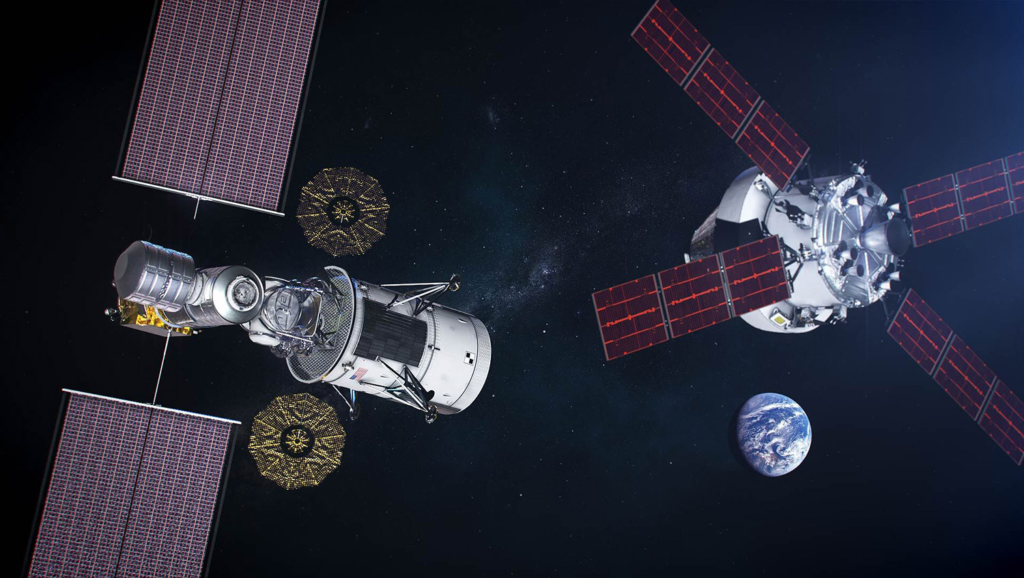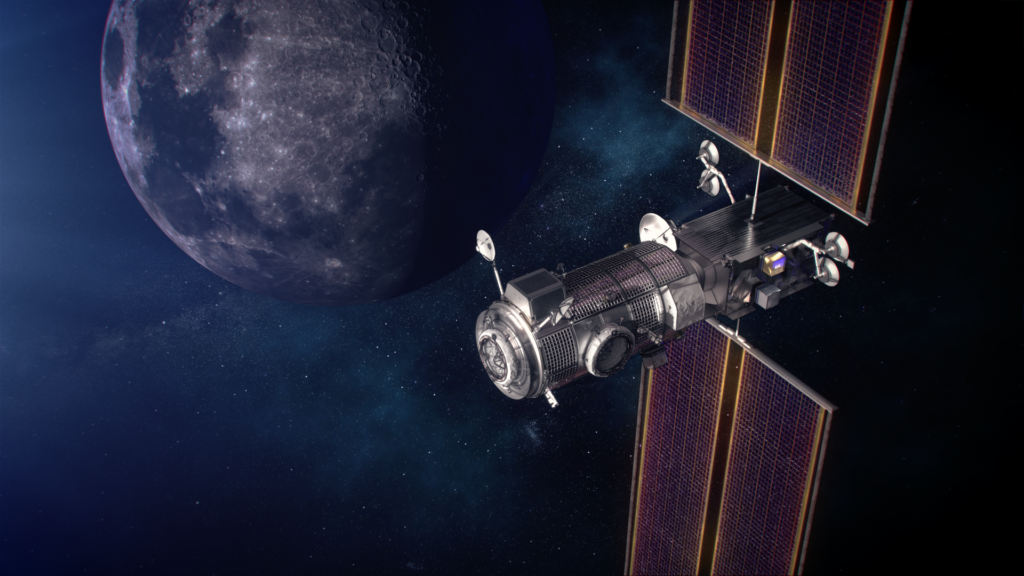
Why Gateway’s Lunar Orbit Is So Important
Throughout all of the Apollo missions, they were only able to access a specific part of the Moon. Artemis on the other hand, is set to have practically the entire Moon available for studies and exploration. This is thanks to the Gateway lunar station and its very unique orbit. Called a Near Rectilinear Halo Orbit (NRHO), Gateway will fly close by the Moon on one side and far away on the other.
At its core, the lunar outpost is specially designed to enable deep space exploration with many capabilities for maintaining a sustained presence in space and conducting research in a deep space environment. However, when it comes to Gateway’s capabilities and what it has to offer, it usually comes back to how it circles the Moon.
Some of the main benefits include better access, favorable science, communications, surface operations, and the environment, just to name a few. All of which will be paramount if NASA wants to not only return humans to the surface but setup a more permanent human presence. Here I will go more in-depth into what an NRHO orbit it, how Gateway will take advantage of it, the tests NASA has performed, and more.
Gateway In NRHO

For Gateway, features like a human habitat, multiple docking ports for a variety of spacecraft, including Orion, and the ability to host experiments that will study space weather will all help contribute to future exploration efforts. Similarly, Gateway’s unique near-rectilinear halo orbit, was specifically chosen to help ensure the success of future Artemis missions.
There is no shortage of options for how a spacecraft could orbit the Moon, but two in particular – low lunar orbit and distant retrograde orbit – are helpful for understanding why NRHO is the right fit for Gateway. A spacecraft in low lunar orbit follows a circular or elliptical path very close to the lunar surface, completing an orbit every two hours. Transit between Gateway and the lunar surface would be quite simple in a low lunar orbit given their proximity, but because of the Moon’s gravity, more propellant is required to maintain the orbit. Therefore, low lunar orbit is not very efficient for Gateway’s planned long-term presence at the Moon – at least 15 years.
Meanwhile, a distant retrograde orbit provides a large, circular, and stable (or more fuel-efficient) orbit that circles the Moon every two weeks. However, what Gateway would gain in a stable orbit, it would lose in easy access to the Moon: the distant orbit would make it harder to get to the lunar surface. A third option, NRHO, is just right for Gateway, marrying the upsides of low lunar orbit (surface access) with the benefits of distant retrograde orbit (fuel efficiency). Hanging almost like a necklace from the Moon, NRHO is a one-week orbit that is balanced between the Earth’s and Moon’s gravity. This orbit will periodically bring Gateway close enough to the lunar surface to provide simple access to the Moon’s South Pole where astronauts will test capabilities for living on other planetary bodies, including Mars. NRHO can also provide astronauts and their spacecraft with access to other landing sites around the Moon in addition to the South Pole.
NASA points out that the benefits of NRHO don’t end with surface access and fuel efficiency. NRHO will allow scientists to take advantage of the deep space environment for a new era of radiation experiments that will inspire a greater understanding of potential impacts of space weather on people and instruments. NRHO will also give Gateway a continuous line of sight, or “view”, of Earth, translating to uninterrupted communication between Earth and the Moon.
A halo orbit is a periodic, three-dimensional orbit associated with one of the L1, L2 and L3 Lagrange points. Near-rectilinear means that some segments of the orbit have a greater curvature than those of an elliptical orbit of the same maximum diameter, and other segments have a curvature less than that of an elliptical orbit of the same maximum diameter (taking maximum diameter as that of the smallest circle that contains the whole of the orbit). Right now, the first two segments for Gateway are nearing completion. Here, the HALO and PPE segment will launch together on a Falcon Heavy and enter this orbit and mark the beginning of Gateway.
CAPSTONE Testing

While this orbit seems perfect for Artemis and NASA’s upcoming plans, the agency wanted to test and make sure. In June 2022, Rocket Lab launched the CAPSTONE spacecraft for NASA. CAPSTONE, or Cislunar Autonomous Positioning System Technology Operations and Navigation Experiment, is a microwave oven–sized CubeSat weighing just 55 pounds meant to test NRHO.
On Nov. 13, CAPSTONE reached the Moon and become the first spacecraft to enter into a unique, elongated orbit that will support NASA’s Artemis missions. The CubeSat serves as a pathfinder for Gateway. CAPSTONE’s mission will help reduce risk for future spacecraft, including Orion, by validating innovative navigation technologies and verifying the dynamics of a type of orbit that has never been flown before. In this special orbit, the pull of gravity from Earth and the Moon interact to allow for a semi-stable orbit. There, physics does most of the work of keeping spacecraft in orbit at the Moon, reducing the need for spacecraft to use fuel to maintain the NRHO compared to other similar orbits.
In the months leading up to its arrival, it was navigating an unusual yet efficient deep space route to the Moon. This route – called a ballistic lunar transfer – follows gravitational contours in deep space and allows spacecraft to reach their destination expending little energy. The trajectory was designed by Advanced Space, a Colorado small business that owns and operates CAPSTONE on behalf of NASA. With CAPSTONE now in the orbit, it will validate the power and propulsion requirements for maintaining its orbit as predicted by NASA’s models, reducing logistical uncertainties. It will also demonstrate the reliability of innovative spacecraft-to-spacecraft navigation solutions as well as communication capabilities with Earth.
To test these new navigation capabilities, CAPSTONE has a second dedicated payload flight computer and radio that will perform calculations to determine where the CubeSat is in its orbital path. Circling the Moon since 2009, NASA’s Lunar Reconnaissance Orbiter (LRO) will serve as a reference point for CAPSTONE. The intention is for CAPSTONE to communicate directly with LRO and utilize the data obtained from this crosslink to measure how far it is from LRO and how fast the distance between the two changes, which in turn determines CAPSTONE’s position in space. This peer-to-peer information will be used to evaluate CAPSTONE’s autonomous navigation software. If successful, this software, referred to as the Cislunar Autonomous Positioning System (CAPS), will allow future spacecraft to determine their location without having to rely exclusively on tracking from Earth. This capability could enable future technology demonstrations to perform on their own without support from the ground and allow ground-based antennas to prioritize valuable science data over more routine operational tracking.
On the spacecraft’s journey however, it did face some problems. Beginning Jan. 26, CAPSTONE was unable to receive commands from ground operators. The spacecraft remained overall healthy and on-course throughout the issue, sending telemetry data back to Earth. On Feb. 6, an automatic command-loss timer rebooted CAPSTONE, clearing the issue and restoring two-way communication between CAPSTONE and the ground. The CAPSTONE team, led by Advanced Space, is now preparing for continued testing of the spacecraft’s Cislunar Autonomous Positioning System, or CAPS, and other technology demonstrations.
The team is also preparing for the mission’s other technology demonstrations, including a new CAPS data type that will use one-way uplink measurements enabled by the spacecraft’s Chip Scale Atomic Clock. Since arriving to orbit on Nov. 13, CAPSTONE has completed more than 12 orbits in its near-rectilinear halo orbit (NRHO) – the same orbit for Gateway – surpassing one of the mission’s objectives to achieve at least six orbits. The mission team has performed two orbit maintenance maneuvers in this time. These maneuvers were originally scheduled to happen once per orbit, but the mission team was able to reduce the frequency while maintaining the correct orbit. This reduces risk and complexity for the mission and informs plans for future spacecraft flying in this orbit, like Gateway.
They point out that following separation from the launch vehicle on July 4th, the navigation team at Advanced Space has maintained excellent knowledge of the spacecraft location in space. Through communication outages, traversing a maximum distance of 1,531,949 km from the Earth, and thruster anomalies that left the spacecraft spinning at a high rate, this knowledge has assisted the spacecraft operations team at Terran Orbital in operating through a variety of challenges. This resiliency is a testament to the CAPSTONE mission team including Advanced Space, Terran Orbital, the Deep Space Network, the Space Dynamics Laboratory, and many others. So far the information gained is already helping NASA with its future plans surrounding Gateway.
Conclusion
NASA is planning to put the Gateway lunar space station in a Near Rectilinear Halo Orbit for future Artemis missions. This specific orbit is unique and provides both fuel efficiency and access to the lunar surface. Both of which are important for a sustained human presence on the Moon. We will have to wait and see how it progresses and the impact it has on the space industry.
